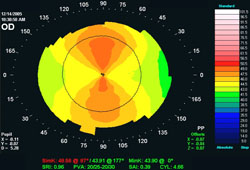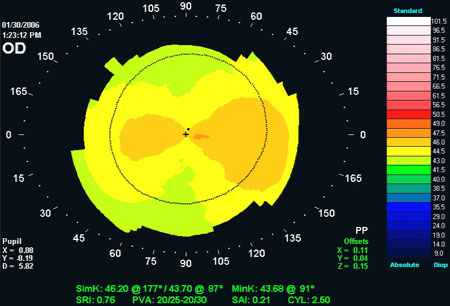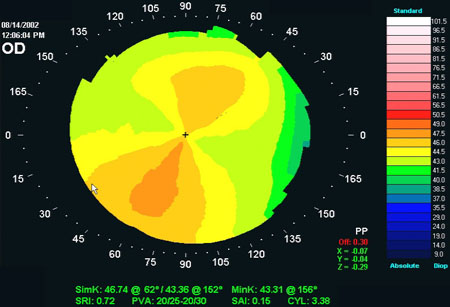Etiology
The exact etiology of astigmatism is unknown, despite extensive research. However, astigmatism is almost always the result of an asymmetric curvature of the refractive surfaces of the ocular media, most commonly the anterior surface of the cornea. Many studies have explored the influence of genetics, but results are inconclusive. Some studies have demonstrated some degree of heritability, while others favor a stronger environmental influence.[17][18] Several genetic syndromes are known to be associated with an increased prevalence of astigmatism, including Down syndrome and Treacher-Collins syndrome. The high prevalence of astigmatism in these patients is believed to result from the characteristic shape of the eyelids in these conditions, which causes pressure to be exerted on the cornea.[19][20] Even in people unaffected by these syndromes, eyelid pathology and pressure from the eyelids during reading can result in changes in corneal topography.[21]
Unequal tension exerted on the cornea by the extraocular muscles may be a possible cause. For example, an increased tension in the medial and lateral recti muscles may lead to a bending of the cornea in the horizontal meridian, causing an against-the-rule astigmatism.[5] This theory is supported by the observation that astigmatism and corneal topography often change significantly following surgery for strabismus.[5][22] Patients with nystagmus also have an increased prevalence of high degrees of astigmatism, although the reason for this is not known.[23]
Other sources of asymmetry can arise from unequal curvatures of the front and back of the crystalline lens or from tilting of the lens.[24]
Pathophysiology
Whatever the cause or source of asymmetric curvature of the refractive surfaces of the ocular media, the result is that the optical system of the eye is unable to accurately focus light onto the retina, producing an image that is distorted and appears blurred.
Classification
Source of astigmatism
Corneal astigmatism: the cornea exhibits a variation of curvature in the different meridians.
Lenticular astigmatism: the lens surfaces are unequally curved.
Total astigmatism: the calculated sum of all the refractive factors, including the cornea and the lens.
Corneal astigmatism classification
Regular astigmatism: each meridian of the cornea is uniform and the 2 principal meridians are at right angles to each other.
Irregular astigmatism: the principal meridians are not at right angles to each other, and the curvature of any meridian is not uniform.
Cylinder axis classification
With-the-rule (WTR) astigmatism: the curvature of the greatest power is in the vertical meridian. [Figure caption and citation for the preceding image starts]: Corneal topography: with-the-rule astigmatismFrom the collection of the Department of Ophthalmology, Assaf Harofeh Medical Center, Israel. Used with permission [Citation ends].

Against-the-rule (ATR) astigmatism: the curvature of the greatest power is in the horizontal meridian. [Figure caption and citation for the preceding image starts]: Corneal topography: against-the-rule astigmatismFrom the collection of the Department of Ophthalmology, Assaf Harofeh Medical Center, Israel. Used with permission [Citation ends].

Oblique astigmatism: the curvature of the greatest power is somewhere between the vertical and horizontal meridians. [Figure caption and citation for the preceding image starts]: Corneal topography: oblique astigmatismFrom the collection of the Department of Ophthalmology, Assaf Harofeh Medical Center, Israel. Used with permission [Citation ends].

Use of this content is subject to our disclaimer